Sir John Monash, Personal Files Book 15, 10 May - 9 June 1917, Part 1
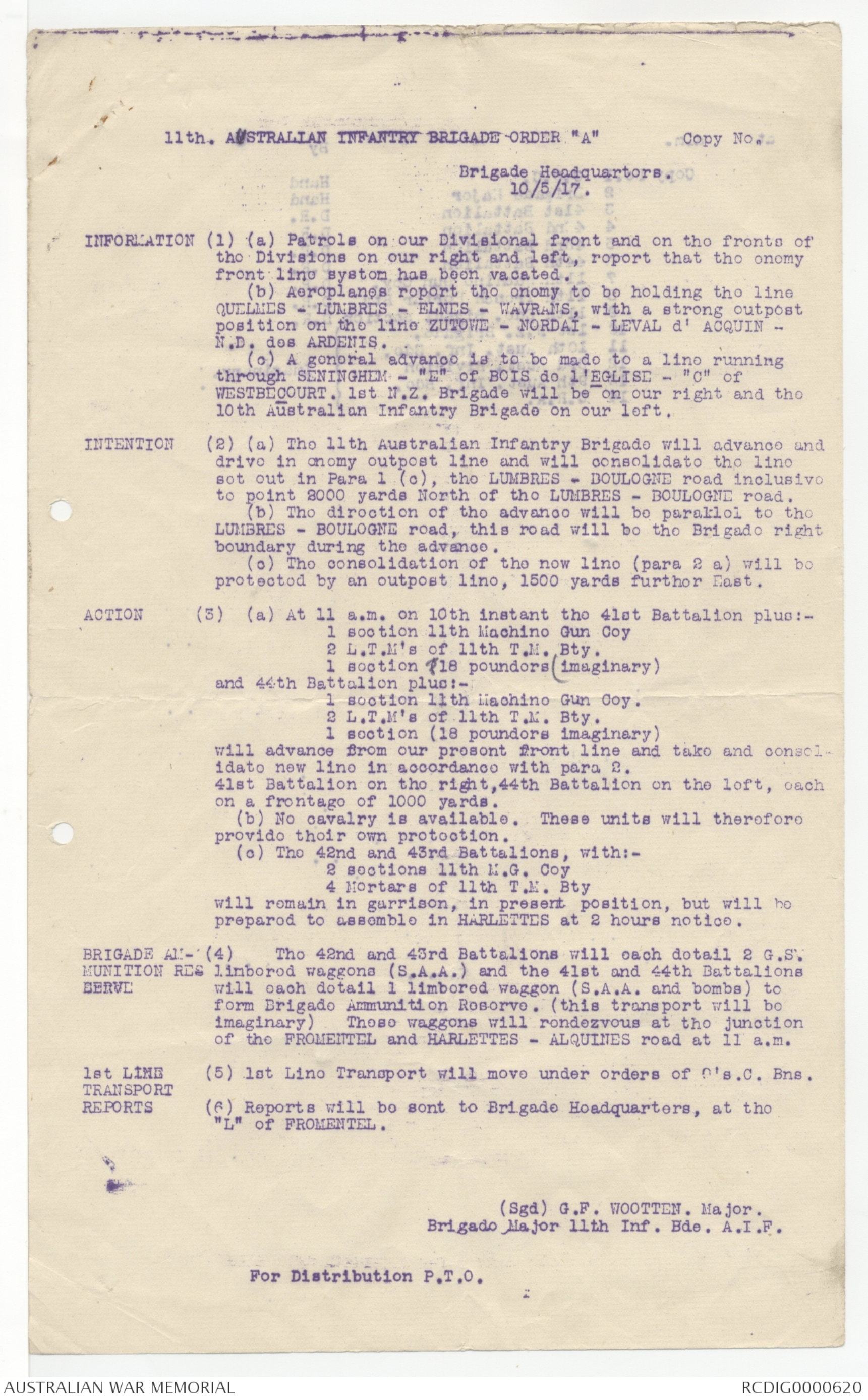
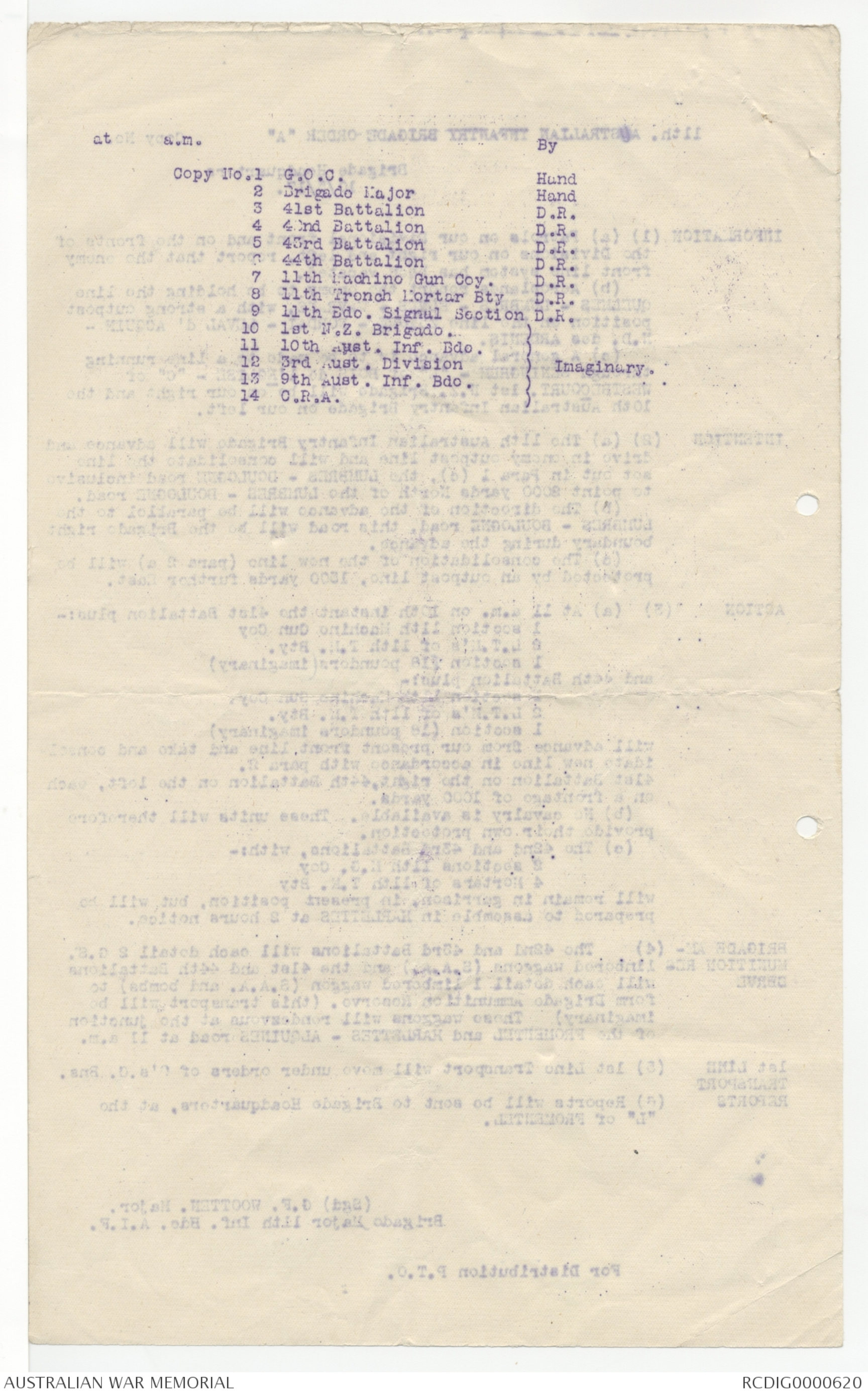
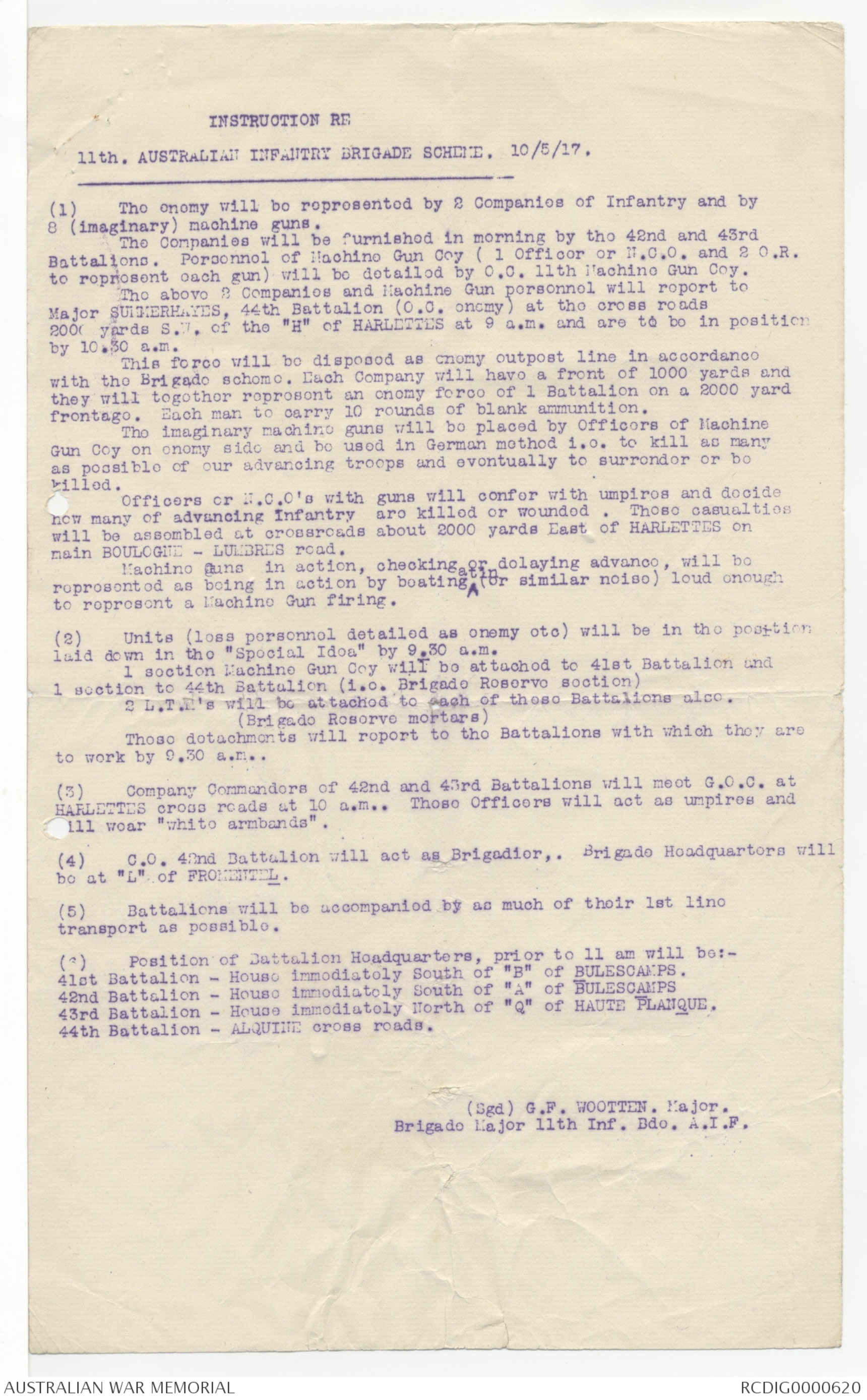
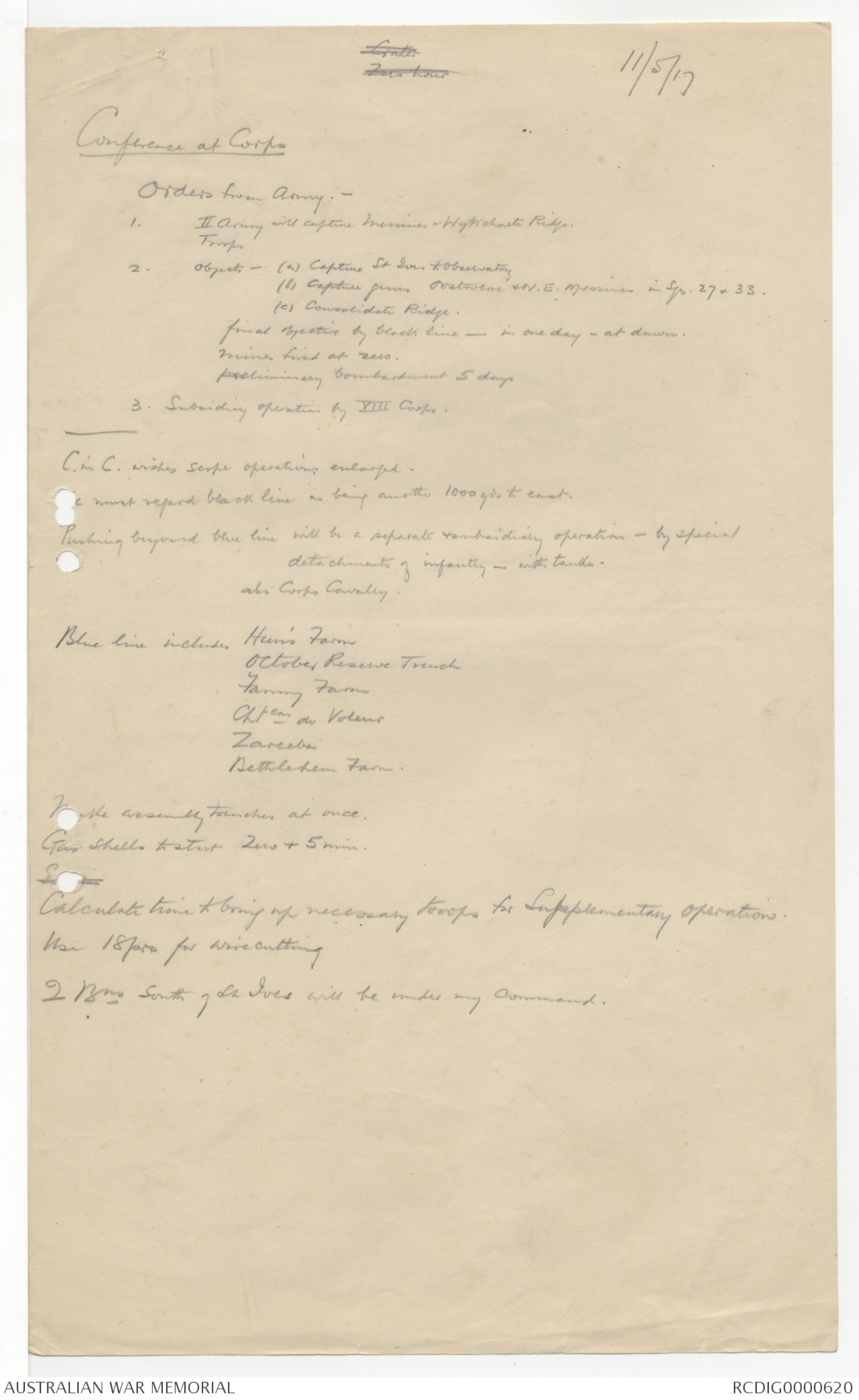
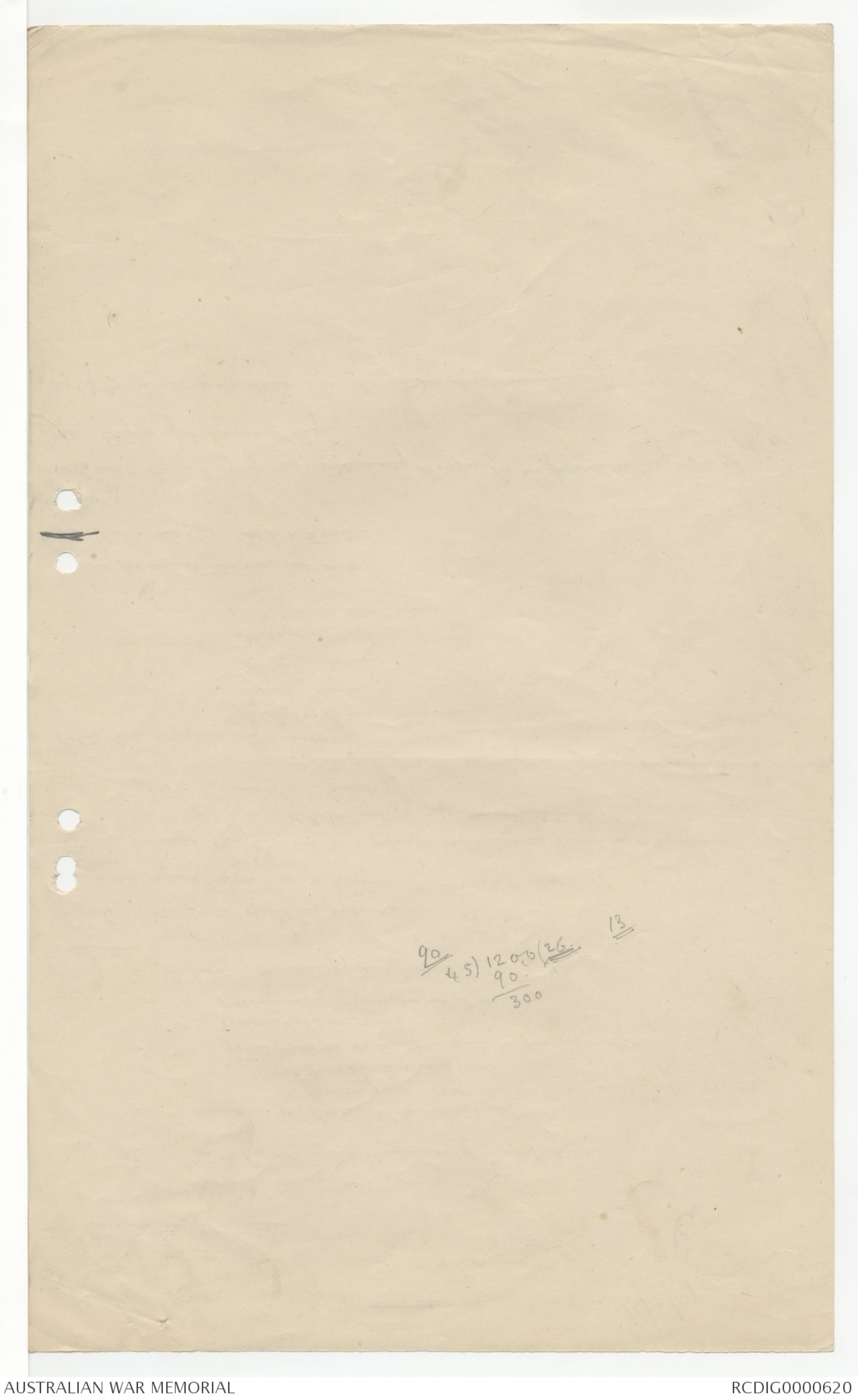
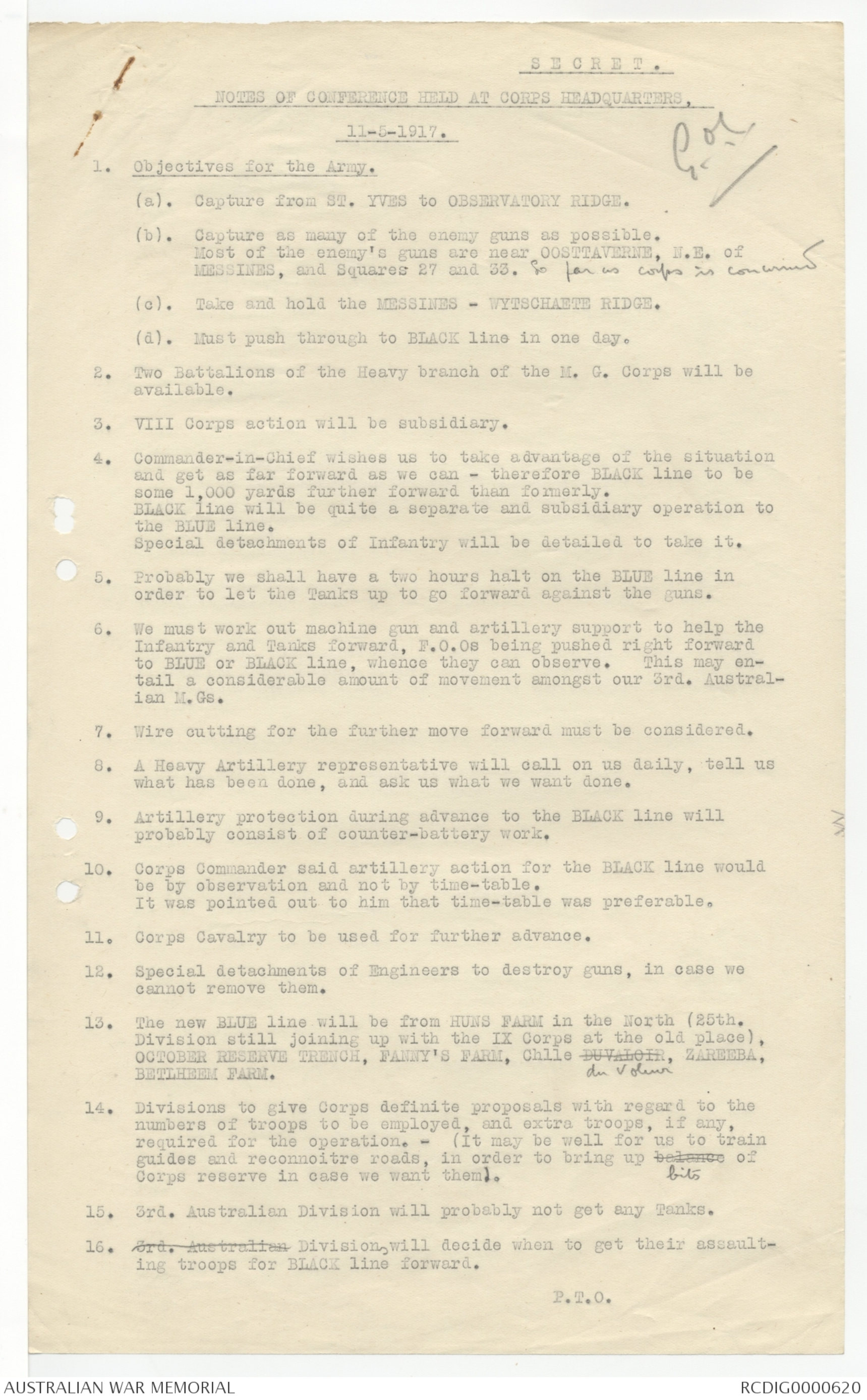
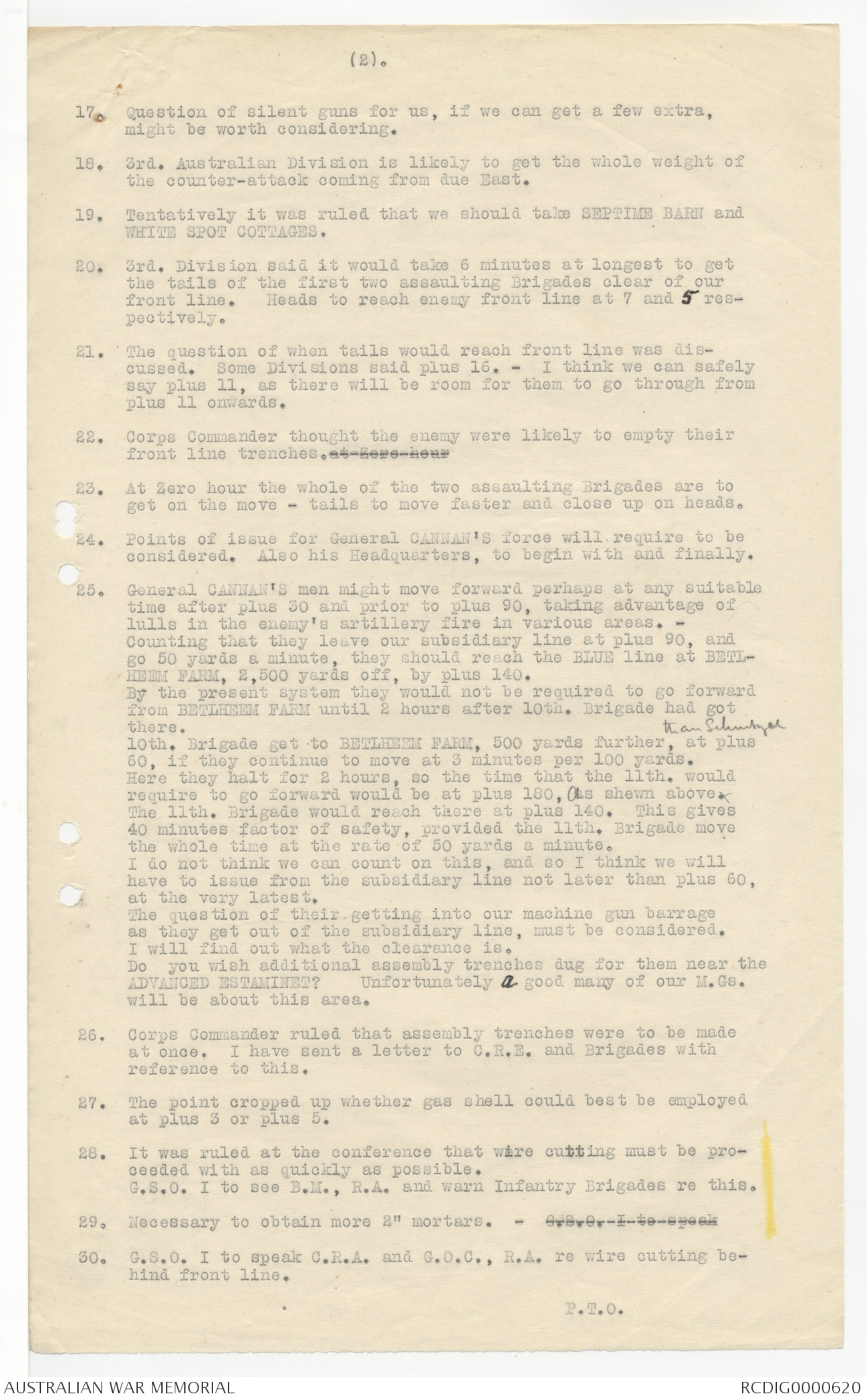
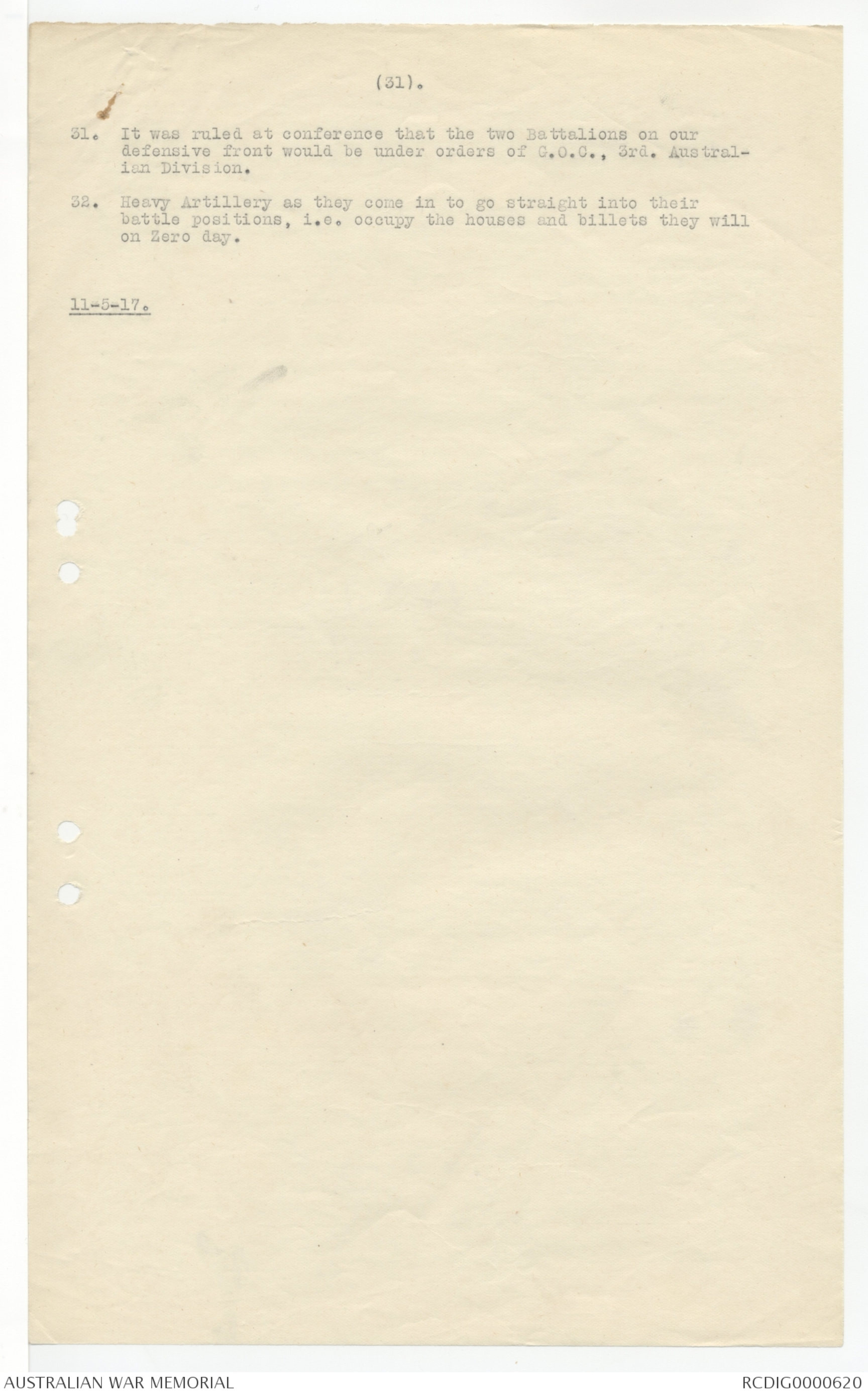
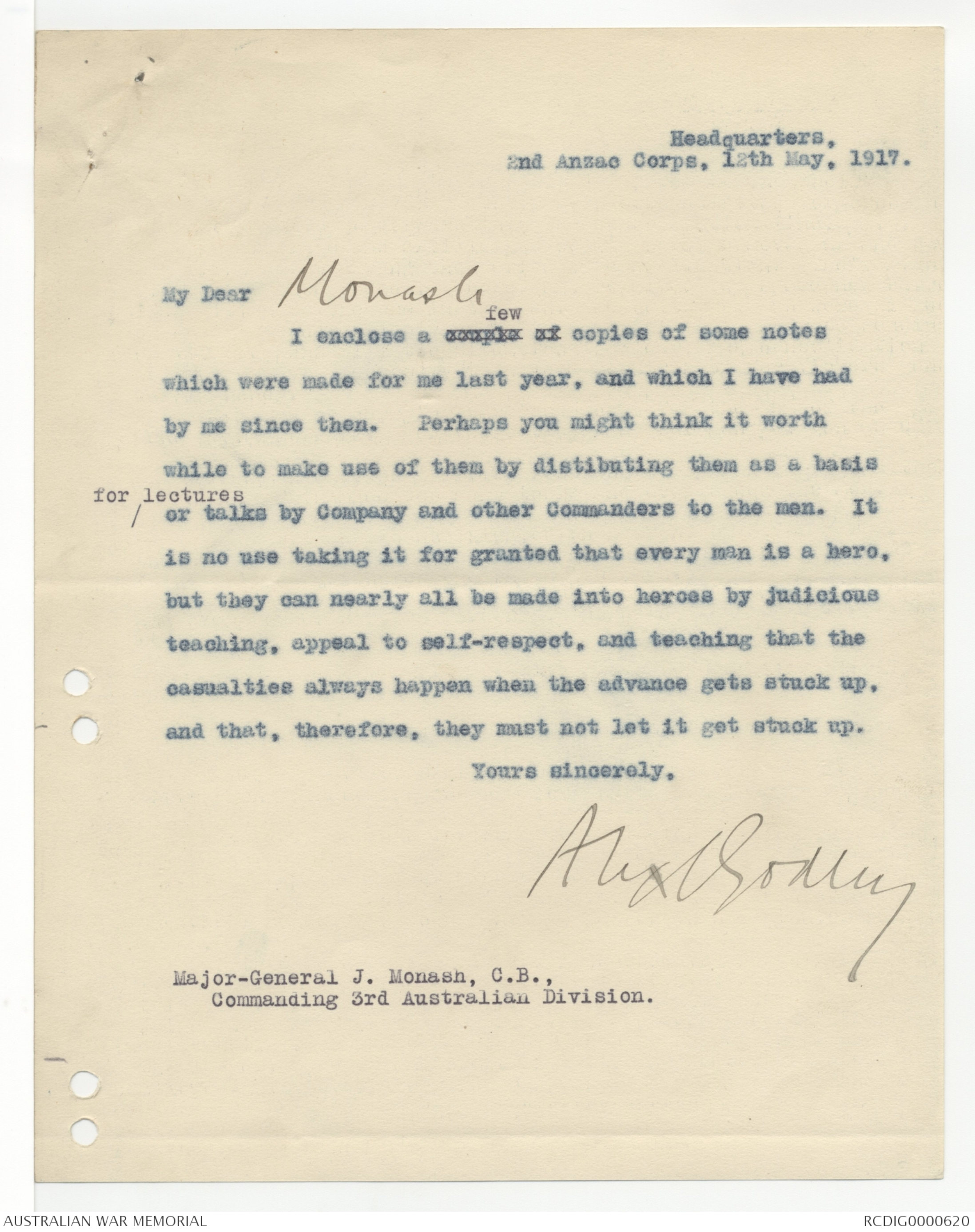
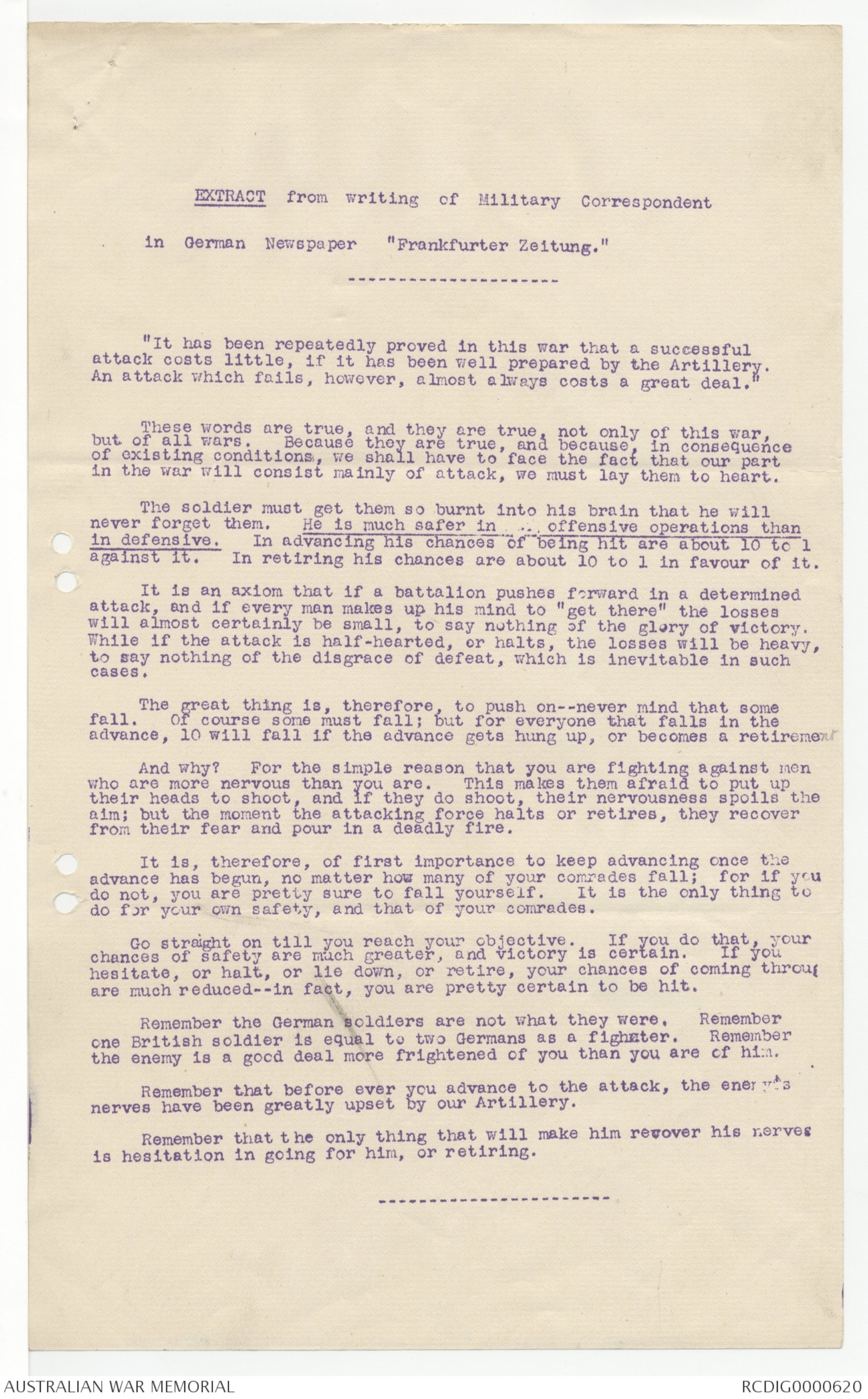
11th. AUSTRALIAN INFANTRY BRIGADE ORDER "A" Copy No.
Brigade Headquarters.
10/05/17.
INFORMATION (1) (a) Patrols on our Divisional front and on the fronts of
the Divisions on our right and left, report that the enemy
front line system has been vacated.
(b) Aeroplanes report the enemy to be holding the line
QUELMES - LUMBRES - ELNES - WAVRANS, with a strong outpost
position on the line ZUTOWE - NORDAI - LEVAL d' ACQUIN ..
N.D. des ARDENIS.
(c) A general advance is to be made to a line running
through SENINGHEM - "E" of Bois de l 'EGLISE - "C" of
WESTBECOURT. 1st N.Z Brigade will be on our right and the
10th Australian Infantry Brigade on our left.
INTENTION (2) (a) The 11th Australian Infantry Brigade will advance and
drive in enemy outpost line and will consolidate the line
set out in Para 1 (c), the LUMBRES - BOULOGNE road inclusive
to point 2000 yards North of the LUMBRES - BOULOGNE road.
(b) The direction of the advance will be parallel to the
LUMBRES - BOULOGNE road, this road will be the Brigade right
boundary during the advance.
(c) The consolidation of the new line (para 2 a) will be
protected by an outpost line, 1500 yards further East.
ACTION (3) (a) At 11 a.m. on 10th Instant the 41st Battalion plus:-
1 section 11th Machine Gun Coy
2 L.T.M's of 11th T.M. Bty.
1 section (18 pounders (imaginary)
and 44th Battalion plus:-
1 section 11th Machine Gun Coy.
2 L.T.M's of 11th T.M. Bty.
1 section (18 pounders imaginary)
will advance from our present front line and take and consolidate
new line in accordance with para 2.
41st Battalion on the right, 44th Battalion on the left, each
on a frontago of 1000 yards.
(b) No cavalry is available. These units will therefore
provido thoir own protoction.
(c) The 42nd and 43rd Battalions, with :-
2 sections 11th M.G. Coy
4 Mortars of 11th T.M. Bty
will remain in garrison, in present position, but will be
preparod to assemble in HARLETTES at 2 hours notice.
BRIGADE AMMUNITION RESSERVE- (4) The 42nd and 43rd Battalions will each detail 2 G.S.
limbered waggons (S.A.A) and the 41st and 44th Battalions
will each detail 1 limbered waggon (S.A.A. and bombs) to
form Brigade Ammunition Reserve. (this transport will be
imaginary). These waggons will rondezvous at tho junction
of the FROMENTEL and HARLETTES - ALQUINES road at 11 a.m.
1st LINE TRANSPORT REPORTS
(5) 1st Lino Transport will move under orders of the O's.C. Bns.
(6) Reports will be sont to Brigade Hoadquarters, at the
"L" of FROMENTEL.
(Sgd) G.F WOOTTEN. Major.
Brigade Major 11th Inf. Bde. A.I.F.
For distribution P.T.O.
at a.m. By
Copy No. 1 G.O.C Hand
2 Brigade Major Hand
3 41st Battalion D.R.
4 42nd Battalion D.R.
5 43rd Battalion D.R.
6 44th Battalion D.R.
7 11th Machine Gun Coy. D.R.
8 11th Trench Mortar Bty D.R.
9 11th Bde. Signal Section D.R.
10 1st N.Z Brigade )
11 10th Aust. Inf. Bde. )
12 3rd Aust. Division ) Imaginary.
13 9th Aust. Inf. Bde. )
14 C.R.A. )
INSTRUCTIONS RE
11th. AUSTRALIAN INFANTRY BRIGADE SCHEME. 10/5/17.
(1) The enemy will be represented by 2 Companies of Infantry and by
8 (imaginary) machine guns.
The Companies will be furnished in morning by the 42nd and 43rd
Battalions. Personnel of Machine Gun Coy (1 Officer or N.C.O and 2 O.R.
to represent each gun) will be detailed by O.C. 11th Machine Gun Coy.
The above 2 Companies and Machine Gun personnel will report to
Major SUMMERHAYES, 44th Battalion (O.C. enemy) at the cross roads
2000 yards S.W. of the "H" of HARLETTES at 9 a.m. and are to be in position
by 10.30 a.m.
This force will be disposed as enemy outpost line in accordance
with the Brigade scheme. Each Company will have a front of 1000 yards and
they will together represent an enemy force of 1 Battalion on a 2000 yard
frontage. Each man to carry 10 rounds of blank ammunition.
The imaginary machine guns will be placed by Officers of Machine
Gun Coy on enemy side and be used in German method i.e. to kill as many
as possible of our advancing troops and eventually to surrender or be
killed.
Officers or N.C.O's with guns will confer with umpires and decide
how many of advancing Infantry are killed or wounded. These casualties
will be assembled at crossroads about 2000 yards East of HARLETTES on
main BOULOGUE - LUMBRES road.
Machine Guns in action, checking or delaying advance, will be
represented as being in action by beating ^a tin (or similar noise) loud enough
to represent a Machine Gun firing.
(2) Units (less personnel detailed as enemy etc) will be in the position
laid down in the "Special Idea" by 9.30 a.m.
1 section Machine Gun Coy will be attached to 41st Battalion and
1 section to 44th Battalion (i.e. Brigade Reserve section)
2 L.T.M's will be attached to each of these Battalions also.
(Brigade Reserve mortars)
Those detachments will report to the Battalions with which they are
to work by 9.30 a.m..
(3) Company Commanders of 42nd and 43rd Battalions will meet G.O.C. at
HARLETTES cross roads at 10 a.m.. These Officers will act as umpires and
will wear "white armbands".
(4) C.O. 42nd Battalion will act as Brigadier,. Brigade Headquartors will
be at "L" of FROMENTEL.
(5) Battalions will be accompanied by as much of their 1st line
transport as possible.
(6) Position of Battalion Headquarters, prior to 11 am will be:-
41st Battalion - House immediately South of "B" of BULESCAMPS.
42nd Battalion - House immediately South of "A" of BULESCAMPS
43rd Battalion - House immediately North of "Q" of HAUTE PLANQUE.
44th Battalion - ALQUINE cross roads.
(Sgd) G.F. WOOTTEN. Major.
Brigade Major 11th Inf. Bdo. A.I.F.
[*CraterZero Hour*]
11/5/17
Conference at Corps
Orders from Army . -
1. II Army will capture Messines - Wytschaete Ridge.
Troops
2. objects- (a) Capture St Ives & Observatory
(b) Capture guns Oosttaverne & N.E. Messines in Sqs. 27 & 33.
(c) Consolidate Ridge.
final objective by black line - in one day - at dawn.
mines fired at zero.
preliminary bombardment 5 days
3. Subsidiary operation by VIII Corps.
C. in C. wishes scope operations enlarged.
[[?]] must regard black line as being another 1000 yds to east.
Pushing beyond blue line will be a separate & subsidiary operation - by special
detachments of infantry - with tanks.
also Corps Cavalry.
Blue line includes Hun's Farm
October Reserve Trench
Fanny Farm
Chteau du Voleus
Zareeba
Bethlehem Farm.
[[?ke]] assembly trenches at once
Gas shells to start Zero + 5 min.SXXX
Calculate time to bring up necessary troops for Supplementary operation.
Use 18 prs for wire cutting
2 Bns South of St Ives will be under my Command.
90
45 ) 1200 (26 13
90
300
SECRET.
NOTES OF CONFERENCE HELD AT CORPS HEADQUARTERS.
11-5-1917.
[*G.O.C*]
- Objectives for the Army.
(a). Capture from ST. YVES to OBSERVATORY RIDGE.
(b). Capture as many of the enemy guns as possible.
Most of the enemy's guns are near OOSTTAVERNE, N.E. of
MESSINES, and Square 27 and 33. So far as corps is concerned.
(c). Take and hold the MESSINES - WYTSCHAETE RIDGE.
(d). Must push through to BLACK line in one day.
2. Two Battalions of the Heavy branch of the M.G. Corps will be
available.
3. VIII Corps action will be subsidiary.
4. Commander-in-Chief wishes us to take advantage of the situation
and get as far forward as we can - therefore BLACK line to be
some 1,000 yards further forward than formerly.
BLACK line will be quite a separate and subsidiary operation to
the BLUE line.
Special detachments of Infantry will be detailed to take it.
5. Probably we shall have a two hours halt on the BLUE line in
order to let the Tanks up to go forward against the guns.
6. We must work out machine gun and artillery support to help the
Infantry and Tanks forward, F.O.Os being pushed right forward
to BLUE or BLACK line, whence they can observe. This may entail
a considerable amount of movement amongst our 3rd. Australian
M.Gs.
7. Wire cutting for the further move forward must be considered.
8. A Heavy Artillery representative will call us daily, tell us
what has been done, and ask us what we want done.
9. Artillery protection during advance to the BLACK line will
probably consist of counter-battery work.
10. Corps Commander said artillery section for the BLACK line would
be by observation and not by time-table.
It was pointed out to him that time-table was preferable.
11. Corps Cavalry to be used for further advance.
12. Special detachments of Engineers to destroy guns, in case we
cannot remove them.
13. The new BLUE line will be from HUNS FARM in the North (25th.
Division still joining up with the IX Corps at the old place),
OCTOBER RESERVE TRENCH, FANNY'S FARM, Chlle DUVALOIR du Voleur, ZAREEBA,
BETLHEEM FARM.
14. Divisions to give Corps definite proposals with regard to the
numbers of troops to be employed, and extra troops, if any,
required for the operation. - (It may be well for us to train
guides and reconnoitre roads, in order to bring up balance bits of
Corps reserve in case we want them).
15. 3rd. Australian Division will probably not get any Tanks.
16. 3rd Australian Divisions will decide when to get their assaulting
troops for BLACK line forward.
P.T.O
(2).
17. Question of silent guns for us, if we can get a few extra,
might be worth considering.
18. 3rd. Australian Division is likely to get the whole weight of
the counter-attack coming from due East.
19. Tentatively it was ruled that we should take SEPTIME BARN and
WHITE SPOT COTTAGES.
20. 3rd. Division said it would take 6 minutes at longest to get
the tails of the first two assaulting Brigades clear of our
front line. Heads to reach enemy front line at 7 and 5 respectively.
21. The question of when tails would reach front line was discussed.
Some Divisions said plus 16. - I think we can safely
say plus 11, as there will be room for them to go through from
plus 11 onwards.
22. Corps Commander thought the enemy were likely to empty their
front line trenches. at Zero hour
23. At Zero hour the whole of the two assaulting Brigades are to
get on the move - tails to move faster and close up on heads.
24. Points of issue for General CANNAN'S force will require to be
considered. Also his Headquarters, to begin with and finally.
25. General CANNAN'S men might move forward perhaps at any suitable
time after plus 30 and prior to plus 90, taking advantage of
lulls in the enemy's artillery fire in various areas. -
Counting that they leave our subsidiary line at plus 90, and
go 50 yards a minute, they should reach the BLUE line at BETLHEEM
FARM, 2,500 yards off, by plus 140.
By the present system they would not be required to go forward
from BETLHEEM FARM until 2 hours after 10th. Brigade had got
there.
10th. Brigade get to BETLHEEM FARM, 500 yards further, than Schnitzel at plus
60, if they continue to move at 3 minutes per 100 yards.
Here they halt for 2 hours, so the time that the 11th. would
require to go forward would be at plus 180, As shewn above.
The 11th. Brigade would reach there at plus 140. This gives
40 minutes factor of safety, provided the 11th. Brigade move
the whole time at the rate of 50 yards a minute.
I do not think we can count on this, and so I think we will
have to issue from the subsidiary line not later than plus 60,
at the very latest.
The question of their getting into our machine gun barrage
as they get out of the subsidiary line, must be considered.
I will find out what the clearance is.
Do you wish additional assembly trenches dug for them near the
ADVANCED ESTAMINET? Unfortunately a good many of our M.Gs.
will be about this area.
26. Corps Commander ruled that assembly trenches were to be made
at once. I have sent a letter to C.R.E. and Brigades with
reference to this.
27. The point cropped up whether gas shell could best be employed
at plus 3 or plus 5.
28. It was ruled at the conference that wire cutting must be proceeded
with as quickly as possible.
G.S.O. I to see B.M., R.A and warn Infantry Brigades re this.
29. Necessary to obtain more 2" mortars. - G.S.O. I to speak
30. G.S.O. I to speak C.R.A. and G.O.C., R.A. re wire cutting behind
front line.
P.T.O.
(31).(31).
31. It was ruled at conference that the two Battalions on our
defensive front would be under orders of G.O.C., 3rd. Australian
Division.
32. Heavy Artillery as they come in to go straight into their
battle positions, i.e. occupy the house and billets they will
on Zero day.
11-5-17.
Headquarters,
2nd Anzac Corps, 12th May, 1917.
My Dear Monash
I enclose a couple of few copies of some notes
which were made for me last year, and which I have had
by me since then. Perhaps you might think it worth
while to make use of them by distributing them as a basis
^ for lectures or talks by Company and other Commanders to the men. It
is no use taking it for granted that every man is a hero,
but they can nearly all be made into heroes by judicious
teaching, appeal to self-respect, and teaching that the
casualties always happen when the advance gets stuck up,
and that, therefore, they must not let it get stuck up.
Yours sincerely
Alex Godley
Major-General J. Monash, C.B.,
Commanding 3rd Australian Division.
EXTRACT from writing of Military Correspondent
in German Newspaper "Frankfurter Zeitung."
"It has been repeatedly proved in this war that a successful
attack costs little, if it has been well prepared by the Artillery.
An attack which fails, however, almost always costs a great deal"
These words are true, and they are true, not only of this war,
but of all wars. Because they are true, and because, in consequence
of existing conditions, we shall have to face the fact that our part
in the war will consist mainly of attack, we must lay them to heart.
The soldier must get them so burnt into his brain that he will
never forget them. He is much safer in .... offensive operations then
in defensive. In advancing his chances of being hit are about 10 to 1
against it. In retiring his chances are about 10 to 1 in favour of it.
It is an axiom that if a battalion pushes forward in a determined
attack, and if every man makes up his mind to "get there" the losses
will almost certainly be small, to say nothing of the glory of victory.
While if the attack is half-hearted, or halts, the losses will be heavy,
to say nothing of the disgrace of defeat, which is inevitable in such
cases.
The great thing is, therefore, to push on--never mind that some
fall. Of course some must fall; but for everyone that falls in the
advance, 10 will fall if the advance gets hung up, or becomes a retirement.
And why? For the simple reason that you are fighting against men
who are more nervous than you are. This makes them afraid to put up
their heads to shoot, and if they do shoot, their nervousness spoils the
aim; but the moment the attacking force halts or retires, they recover
from their fear and pour in a deadly fire.
It is, therefore, of first importance to keep advancing once the
advance has begun, no matter how many of your comrades fall; for if you
do not, you are pretty sure to fall yourself. It is the only thing to
do for your own safety, and that of your comrades.
Go straight on till you reach your objective. If you do that, your
chances of safety are much greater, and victory is certain. If you
hesitate, or halt, or lie down, or retire, your chances of coming through
are much reduced--in fact, you are pretty certain to be hit.
Remember the German soldiers are not what they were. Remember
one British soldier is equal to two Germans as a fighxter. Remember
the enemy is good deal more frightened of you than you are of him.
Remember that before ever you advance to the attack, the enemy's
nerves have been greatly upset by our Artillery.
Remember that t he only thing that will make him recover his nerves
is hesitation in going for him, or retiring.
 Deb Parkinson
Deb ParkinsonThis transcription item is now locked to you for editing. To release the lock either Save your changes or Cancel.
This lock will be automatically released after 60 minutes of inactivity.